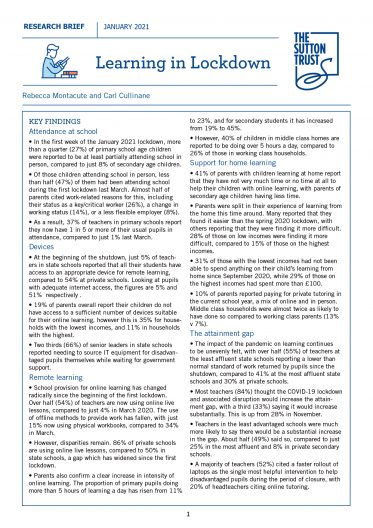Attendance at school
• In the first week of the January 2021 lockdown, more than a quarter (27%) of primary school age children were reported to be at least partially attending school in person, compared to just 8% of secondary age children.
• Of those children attending school in person, less than half (47%) of them had been attending school during the first lockdown last March.
• As a result, 37% of teachers in primary schools report they now have 1 in 5 or more of their usual pupils in attendance, compared to just 1% last March.
Devices
• At the beginning of the shutdown, just 5% of teachers in state schools reported that all their students have access to an appropriate device for remote learning, compared to 54% at private schools.
• 19% of parents overall report their children do not have access to a sufficient number of devices suitable for their online learning, however this is 35% for households with the lowest incomes, and 11% in households with the highest.
Remote learning
• School provision for online learning has changed radically since the beginning of the first lockdown. Over half (54%) of teachers are now using online live lessons, compared to just 4% in March 2020. The use of offline methods to provide work has fallen, with just 15% now using physical workbooks, compared to 34% in March.
• However, disparities remain. 86% of private schools are using online live lessons, compared to 50% in state schools, a gap which has widened since the first lockdown.
• The proportion of primary pupils doing more than 5 hours of learning a day has risen from 11% to 23%, and for secondary students it has increased from 19% to 45%.
• However, 40% of children in middle class homes are reported to be doing over 5 hours a day, compared to 26% of those in working class households.
Support for home learning
• 41% of parents with children learning at home report that they have not very much time or no time at all to help their children with online learning.
• Parents were split in their experience of learning from the home this time around. 28% of those on low incomes were finding it more difficult, compared to 15% of those on the highest incomes.
• 31% of those with the lowest incomes had not been able to spend anything on their child’s learning from home since September 2020, while 29% of those on the highest incomes had spent more than £100.
The attainment gap
• The impact of the pandemic on learning continues to be unevenly felt, with over half (55%) of teachers at the least affluent state schools reporting a lower than normal standard of work returned by pupils since the shutdown, compared to 41% at the most affluent state schools and 30% at private schools.
• Most teachers (84%) thought the COVID-19 lockdown and associated disruption would increase the attainment gap, with a third (33%) saying it would increase substantially. This is up from 28% in November.
• Teachers in the least advantaged schools were much more likely to say there would be a substantial increase in the gap.
• A majority of teachers (52%) cited a faster rollout of laptops as the single most helpful intervention to help disadvantaged pupils during the period of closure, with 20% of headteachers citing online tutoring.
